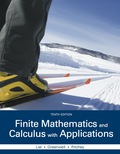
EBK FINITE MATHEMATICS AND CALCULUS WIT
10th Edition
ISBN: 8220102020252
Author: RITCHEY
Publisher: PEARSON
expand_more
expand_more
format_list_bulleted
Question
Chapter 15.1, Problem 4E
To determine
To explain: The reason for the restriction of using
Expert Solution & Answer
Want to see the full answer?
Check out a sample textbook solution
Students have asked these similar questions
Can you answer this question and give step by step and why and how to get it. Can you write it (numerical method)
Can you answer this question and give step by step and why and how to get it. Can you write it (numerical method)
There are three options for investing $1150. The first earns 10% compounded annually, the second earns 10% compounded quarterly, and the third earns 10% compounded continuously. Find equations that model each investment growth and
use a graphing utility to graph each model in the same viewing window over a 20-year period. Use the graph to determine which investment yields the highest return after 20 years. What are the differences in earnings among the three
investment?
STEP 1: The formula for compound interest is
A =
nt
= P(1 + − − ) n²,
where n is the number of compoundings per year, t is the number of years, r is the interest rate, P is the principal, and A is the amount (balance) after t years. For continuous compounding, the formula reduces to
A = Pert
Find r and n for each model, and use these values to write A in terms of t for each case.
Annual Model
r=0.10
A = Y(t) = 1150 (1.10)*
n = 1
Quarterly Model
r = 0.10
n = 4
A = Q(t) = 1150(1.025) 4t
Continuous Model
r=0.10
A = C(t) =…
Chapter 15 Solutions
EBK FINITE MATHEMATICS AND CALCULUS WIT
Ch. 15.1 - Find an antiderivative f(x)=8x7.Ch. 15.1 - Find 1t4dt.Ch. 15.1 - Find (6x2+8x9)dx.Ch. 15.1 - Find x32xdx.Ch. 15.1 - Find (3x+e3x)dx.Ch. 15.1 - Repeat Example 11(b) and 11(c) for the Burj...Ch. 15.1 - Prob. 7YTCh. 15.1 - Find the derivative of the following functions....Ch. 15.1 - Find the derivative of the following functions....Ch. 15.1 - Prob. 1E
Ch. 15.1 - Prob. 2ECh. 15.1 - Prob. 3ECh. 15.1 - Prob. 4ECh. 15.1 - Prob. 5ECh. 15.1 - Prob. 6ECh. 15.1 - Prob. 7ECh. 15.1 - Prob. 8ECh. 15.1 - Prob. 9ECh. 15.1 - Prob. 10ECh. 15.1 - Prob. 11ECh. 15.1 - Prob. 12ECh. 15.1 - Prob. 13ECh. 15.1 - Prob. 14ECh. 15.1 - Prob. 15ECh. 15.1 - Prob. 16ECh. 15.1 - Prob. 17ECh. 15.1 - Prob. 18ECh. 15.1 - Prob. 19ECh. 15.1 - Prob. 20ECh. 15.1 - Prob. 21ECh. 15.1 - Prob. 22ECh. 15.1 - Prob. 23ECh. 15.1 - Prob. 24ECh. 15.1 - Prob. 25ECh. 15.1 - Prob. 26ECh. 15.1 - Prob. 27ECh. 15.1 - Prob. 28ECh. 15.1 - Prob. 29ECh. 15.1 - Prob. 30ECh. 15.1 - Prob. 31ECh. 15.1 - Prob. 32ECh. 15.1 - Prob. 33ECh. 15.1 - Prob. 34ECh. 15.1 - Prob. 35ECh. 15.1 - Prob. 36ECh. 15.1 - Prob. 37ECh. 15.1 - Prob. 38ECh. 15.1 - Prob. 39ECh. 15.1 - Prob. 40ECh. 15.1 - Prob. 41ECh. 15.1 - Prob. 42ECh. 15.1 - Prob. 43ECh. 15.1 - Prob. 44ECh. 15.1 - APPLICATIONS Business and Economics Cost Find the...Ch. 15.1 - Prob. 46ECh. 15.1 - Prob. 47ECh. 15.1 - Cost Find the cost function for each marginal cost...Ch. 15.1 - Prob. 49ECh. 15.1 - Prob. 50ECh. 15.1 - Prob. 51ECh. 15.1 - Prob. 52ECh. 15.1 - Prob. 53ECh. 15.1 - Prob. 54ECh. 15.1 - Prob. 55ECh. 15.1 - Prob. 56ECh. 15.1 - Prob. 57ECh. 15.1 - Prob. 58ECh. 15.1 - Prob. 59ECh. 15.1 - Prob. 60ECh. 15.1 - Prob. 61ECh. 15.1 - Prob. 62ECh. 15.1 - Cell Growth Under certain conditions, the number...Ch. 15.1 - Prob. 64ECh. 15.1 - Prob. 65ECh. 15.1 - Prob. 66ECh. 15.1 - Prob. 67ECh. 15.1 - Prob. 68ECh. 15.1 - Prob. 69ECh. 15.1 - Prob. 70ECh. 15.1 - Prob. 71ECh. 15.1 - Prob. 72ECh. 15.1 - Prob. 73ECh. 15.1 - Prob. 74ECh. 15.2 - Prob. 1YTCh. 15.2 - Prob. 2YTCh. 15.2 - Prob. 3YTCh. 15.2 - Prob. 4YTCh. 15.2 - Prob. 5YTCh. 15.2 - Prob. 6YTCh. 15.2 - Prob. 1WECh. 15.2 - Prob. 2WECh. 15.2 - Prob. 3WECh. 15.2 - Prob. 1ECh. 15.2 - Prob. 2ECh. 15.2 - Prob. 3ECh. 15.2 - Prob. 4ECh. 15.2 - Prob. 5ECh. 15.2 - Prob. 6ECh. 15.2 - Prob. 7ECh. 15.2 - Prob. 8ECh. 15.2 - Prob. 9ECh. 15.2 - Prob. 10ECh. 15.2 - Prob. 11ECh. 15.2 - Prob. 12ECh. 15.2 - Prob. 13ECh. 15.2 - Prob. 14ECh. 15.2 - Prob. 15ECh. 15.2 - Prob. 16ECh. 15.2 - Prob. 17ECh. 15.2 - Prob. 18ECh. 15.2 - Prob. 19ECh. 15.2 - Prob. 20ECh. 15.2 - Prob. 21ECh. 15.2 - Prob. 22ECh. 15.2 - Prob. 23ECh. 15.2 - Prob. 24ECh. 15.2 - Prob. 25ECh. 15.2 - Prob. 26ECh. 15.2 - Prob. 27ECh. 15.2 - Prob. 28ECh. 15.2 - Prob. 29ECh. 15.2 - Prob. 30ECh. 15.2 - Prob. 31ECh. 15.2 - Prob. 32ECh. 15.2 - Prob. 33ECh. 15.2 - Prob. 34ECh. 15.2 - Prob. 35ECh. 15.2 - Prob. 36ECh. 15.2 - Prob. 37ECh. 15.2 - Prob. 38ECh. 15.2 - Prob. 39ECh. 15.2 - Prob. 40ECh. 15.2 - Prob. 41ECh. 15.2 - Prob. 42ECh. 15.2 - Prob. 43ECh. 15.2 - Prob. 44ECh. 15.2 - Prob. 45ECh. 15.2 - Prob. 46ECh. 15.3 - Prob. 1YTCh. 15.3 - Prob. 2YTCh. 15.3 - Prob. 1ECh. 15.3 - Prob. 2ECh. 15.3 - Prob. 3ECh. 15.3 - Prob. 4ECh. 15.3 - Prob. 5ECh. 15.3 - In Exercises 512, approximate the area under the...Ch. 15.3 - Prob. 7ECh. 15.3 - In Exercises 512, approximate the area under the...Ch. 15.3 - Prob. 9ECh. 15.3 - Prob. 10ECh. 15.3 - Prob. 11ECh. 15.3 - Prob. 12ECh. 15.3 - Prob. 13ECh. 15.3 - Prob. 14ECh. 15.3 - Prob. 15ECh. 15.3 - Prob. 16ECh. 15.3 - Prob. 17ECh. 15.3 - Prob. 18ECh. 15.3 - Prob. 19ECh. 15.3 - Prob. 20ECh. 15.3 - Prob. 21ECh. 15.3 - Prob. 22ECh. 15.3 - Prob. 24ECh. 15.3 - Prob. 25ECh. 15.3 - Prob. 26ECh. 15.3 - Prob. 27ECh. 15.3 - Prob. 28ECh. 15.3 - Prob. 29ECh. 15.3 - Prob. 30ECh. 15.3 - Prob. 31ECh. 15.3 - Prob. 32ECh. 15.3 - Prob. 33ECh. 15.3 - Prob. 34ECh. 15.3 - Prob. 35ECh. 15.3 - Prob. 36ECh. 15.3 - Prob. 37ECh. 15.3 - Prob. 38ECh. 15.3 - Prob. 39ECh. 15.3 - Prob. 40ECh. 15.4 - Prob. 1YTCh. 15.4 - Prob. 2YTCh. 15.4 - Prob. 3YTCh. 15.4 - Prob. 4YTCh. 15.4 - Prob. 5YTCh. 15.4 - Prob. 1WECh. 15.4 - Prob. 2WECh. 15.4 - Prob. 3WECh. 15.4 - Prob. 1ECh. 15.4 - Prob. 2ECh. 15.4 - Prob. 3ECh. 15.4 - Prob. 4ECh. 15.4 - Prob. 5ECh. 15.4 - Prob. 6ECh. 15.4 - Prob. 7ECh. 15.4 - Prob. 8ECh. 15.4 - Prob. 9ECh. 15.4 - Prob. 10ECh. 15.4 - Prob. 11ECh. 15.4 - Prob. 12ECh. 15.4 - Prob. 13ECh. 15.4 - Prob. 14ECh. 15.4 - Prob. 15ECh. 15.4 - Prob. 16ECh. 15.4 - Prob. 17ECh. 15.4 - Prob. 18ECh. 15.4 - Prob. 19ECh. 15.4 - Prob. 20ECh. 15.4 - Prob. 21ECh. 15.4 - Prob. 22ECh. 15.4 - Prob. 23ECh. 15.4 - Prob. 24ECh. 15.4 - Prob. 25ECh. 15.4 - Prob. 26ECh. 15.4 - Prob. 27ECh. 15.4 - Prob. 28ECh. 15.4 - Prob. 29ECh. 15.4 - Prob. 30ECh. 15.4 - Prob. 31ECh. 15.4 - Prob. 32ECh. 15.4 - Prob. 33ECh. 15.4 - Prob. 34ECh. 15.4 - Prob. 35ECh. 15.4 - Prob. 36ECh. 15.4 - Prob. 37ECh. 15.4 - Prob. 38ECh. 15.4 - Prob. 39ECh. 15.4 - Prob. 40ECh. 15.4 - Prob. 41ECh. 15.4 - Prob. 42ECh. 15.4 - Prob. 43ECh. 15.4 - Prob. 44ECh. 15.4 - Prob. 45ECh. 15.4 - Prob. 46ECh. 15.4 - Prob. 47ECh. 15.4 - Prob. 48ECh. 15.4 - Prob. 49ECh. 15.4 - Prob. 50ECh. 15.4 - Prob. 51ECh. 15.4 - Prob. 52ECh. 15.4 - Prob. 53ECh. 15.4 - Prob. 54ECh. 15.4 - Prob. 55ECh. 15.4 - Prob. 56ECh. 15.4 - Prob. 57ECh. 15.4 - Prob. 58ECh. 15.4 - Prob. 59ECh. 15.4 - Prob. 60ECh. 15.4 - Prob. 61ECh. 15.4 - Prob. 62ECh. 15.4 - Prob. 63ECh. 15.4 - Prob. 64ECh. 15.4 - Prob. 65ECh. 15.4 - Prob. 66ECh. 15.4 - Beagles The daily energy requirements of female...Ch. 15.4 - Prob. 68ECh. 15.4 - Prob. 69ECh. 15.4 - Prob. 70ECh. 15.4 - Prob. 71ECh. 15.4 - Prob. 72ECh. 15.5 - Repeat Example 1 for f(x) = 4 x2, g(x) = x + 2, x...Ch. 15.5 - Prob. 2YTCh. 15.5 - Repeat Example 3 for y = x2 3x and y = 2x on [0,...Ch. 15.5 - Prob. 4YTCh. 15.5 - Evaluate each of the following integrals....Ch. 15.5 - Prob. 2WECh. 15.5 - Prob. 1ECh. 15.5 - Prob. 2ECh. 15.5 - Prob. 3ECh. 15.5 - Prob. 4ECh. 15.5 - Prob. 5ECh. 15.5 - Prob. 6ECh. 15.5 - Prob. 7ECh. 15.5 - Prob. 8ECh. 15.5 - Prob. 9ECh. 15.5 - Prob. 10ECh. 15.5 - Prob. 11ECh. 15.5 - Prob. 12ECh. 15.5 - Prob. 13ECh. 15.5 - Prob. 14ECh. 15.5 - Prob. 15ECh. 15.5 - Prob. 16ECh. 15.5 - Prob. 17ECh. 15.5 - Prob. 18ECh. 15.5 - Prob. 19ECh. 15.5 - Prob. 20ECh. 15.5 - Prob. 21ECh. 15.5 - Prob. 22ECh. 15.5 - Prob. 23ECh. 15.5 - Prob. 24ECh. 15.5 - Prob. 25ECh. 15.5 - Prob. 26ECh. 15.5 - Prob. 27ECh. 15.5 - Prob. 28ECh. 15.5 - Prob. 29ECh. 15.5 - Prob. 30ECh. 15.5 - Prob. 31ECh. 15.5 - Prob. 32ECh. 15.5 - Consumers Surplus Find the consumers surplus if...Ch. 15.5 - Prob. 34ECh. 15.5 - Consumers and Producers Surplus Suppose the supply...Ch. 15.5 - Consumers and Producers Surplus Suppose the supply...Ch. 15.5 - Consumers and Producers Surplus Suppose that with...Ch. 15.5 - Prob. 38ECh. 15.5 - Prob. 39ECh. 15.5 - Prob. 40ECh. 15.5 - Prob. 41ECh. 15.5 - Prob. 42ECh. 15.6 - Prob. 1YTCh. 15.6 - Prob. 2YTCh. 15.6 - Prob. 1ECh. 15.6 - Prob. 2ECh. 15.6 - Prob. 3ECh. 15.6 - Prob. 4ECh. 15.6 - Prob. 5ECh. 15.6 - Prob. 6ECh. 15.6 - Prob. 7ECh. 15.6 - Prob. 8ECh. 15.6 - Prob. 9ECh. 15.6 - Prob. 10ECh. 15.6 - Prob. 11ECh. 15.6 - Prob. 12ECh. 15.6 - Prob. 13ECh. 15.6 - Prob. 14ECh. 15.6 - Exercises 1518 require both the trapezoidal rule...Ch. 15.6 - Prob. 16ECh. 15.6 - Prob. 17ECh. 15.6 - Prob. 18ECh. 15.6 - Prob. 19ECh. 15.6 - Prob. 20ECh. 15.6 - Prob. 21ECh. 15.6 - Prob. 22ECh. 15.6 - Prob. 23ECh. 15.6 - Prob. 24ECh. 15.6 - Prob. 25ECh. 15.6 - Prob. 26ECh. 15.6 - Prob. 27ECh. 15.6 - Prob. 28ECh. 15.6 - Prob. 29ECh. 15.6 - Prob. 30ECh. 15.6 - Prob. 31ECh. 15.6 - Prob. 32ECh. 15.6 - Prob. 33ECh. 15.6 - Prob. 34ECh. 15.6 - Prob. 35ECh. 15 - Determine whether each of the following statements...Ch. 15 - Prob. 2RECh. 15 - Prob. 3RECh. 15 - Prob. 4RECh. 15 - Determine whether each of the following statements...Ch. 15 - Prob. 6RECh. 15 - Prob. 7RECh. 15 - Prob. 8RECh. 15 - Prob. 9RECh. 15 - Prob. 10RECh. 15 - Prob. 11RECh. 15 - Prob. 12RECh. 15 - Prob. 13RECh. 15 - Prob. 14RECh. 15 - Prob. 15RECh. 15 - Prob. 16RECh. 15 - Prob. 17RECh. 15 - Prob. 18RECh. 15 - Prob. 19RECh. 15 - Prob. 20RECh. 15 - Prob. 21RECh. 15 - Prob. 22RECh. 15 - Prob. 23RECh. 15 - Prob. 24RECh. 15 - Prob. 25RECh. 15 - Prob. 26RECh. 15 - Prob. 27RECh. 15 - Prob. 28RECh. 15 - Prob. 29RECh. 15 - Prob. 30RECh. 15 - Prob. 31RECh. 15 - Prob. 32RECh. 15 - Prob. 33RECh. 15 - Prob. 34RECh. 15 - Prob. 35RECh. 15 - Prob. 36RECh. 15 - Prob. 37RECh. 15 - Prob. 38RECh. 15 - Prob. 39RECh. 15 - Prob. 40RECh. 15 - Prob. 41RECh. 15 - Prob. 42RECh. 15 - Prob. 43RECh. 15 - Prob. 44RECh. 15 - Prob. 45RECh. 15 - Prob. 46RECh. 15 - Prob. 47RECh. 15 - Prob. 48RECh. 15 - Prob. 49RECh. 15 - Prob. 50RECh. 15 - Prob. 51RECh. 15 - Prob. 52RECh. 15 - Prob. 53RECh. 15 - Prob. 54RECh. 15 - Prob. 55RECh. 15 - Prob. 56RECh. 15 - Prob. 57RECh. 15 - Prob. 58RECh. 15 - Prob. 59RECh. 15 - Prob. 60RECh. 15 - Prob. 61RECh. 15 - Prob. 62RECh. 15 - Prob. 63RECh. 15 - Prob. 64RECh. 15 - Prob. 65RECh. 15 - Prob. 66RECh. 15 - Prob. 67RECh. 15 - Prob. 68RECh. 15 - Prob. 69RECh. 15 - Prob. 70RECh. 15 - Prob. 71RECh. 15 - Prob. 72RECh. 15 - Prob. 73RECh. 15 - Prob. 74RECh. 15 - Prob. 75RECh. 15 - Prob. 76RECh. 15 - Prob. 77RECh. 15 - Prob. 78RECh. 15 - Prob. 79RECh. 15 - Prob. 80RECh. 15 - Prob. 81RECh. 15 - Prob. 82RECh. 15 - Sales The rate of change of sales of a new brand...Ch. 15 - Prob. 84RECh. 15 - Prob. 85RECh. 15 - Prob. 86RECh. 15 - QD 87. Oil Production The following table shows...Ch. 15 - Prob. 88RECh. 15 - Prob. 89RECh. 15 - Prob. 90RECh. 15 - Prob. 91RECh. 15 - Prob. 92RECh. 15 - Prob. 93RECh. 15 - Prob. 94RECh. 15 - Prob. 95RE
Knowledge Booster
Learn more about
Need a deep-dive on the concept behind this application? Look no further. Learn more about this topic, calculus and related others by exploring similar questions and additional content below.Similar questions
- Use a graphing utility to find the point of intersection, if any, of the graphs of the functions. Round your result to three decimal places. (Enter NONE in any unused answer blanks.) y = 100e0.01x (x, y) = y = 11,250 ×arrow_forward5. For the function y-x³-3x²-1, use derivatives to: (a) determine the intervals of increase and decrease. (b) determine the local (relative) maxima and minima. (e) determine the intervals of concavity. (d) determine the points of inflection. (e) sketch the graph with the above information indicated on the graph.arrow_forwardCan you solve this 2 question numerical methodarrow_forward
- 1. Estimate the area under the graph of f(x)-25-x from x=0 to x=5 using 5 approximating rectangles Using: (A) right endpoints. (B) left endpoints.arrow_forward9. Use fundamental theorem of calculus to find the derivative d a) *dt sin(x) b)(x)√1-2 dtarrow_forward3. Evaluate the definite integral: a) √66x²+8dx b) x dx c) f*(2e* - 2)dx d) √√9-x² e) (2-5x)dx f) cos(x)dx 8)²₁₂√4-x2 h) f7dx i) f² 6xdx j) ²₂(4x+3)dxarrow_forward
- 2. Consider the integral √(2x+1)dx (a) Find the Riemann sum for this integral using right endpoints and n-4. (b) Find the Riemann sum for this same integral, using left endpoints and n=4arrow_forwardProblem 11 (a) A tank is discharging water through an orifice at a depth of T meter below the surface of the water whose area is A m². The following are the values of a for the corresponding values of A: A 1.257 1.390 x 1.50 1.65 1.520 1.650 1.809 1.962 2.123 2.295 2.462|2.650 1.80 1.95 2.10 2.25 2.40 2.55 2.70 2.85 Using the formula -3.0 (0.018)T = dx. calculate T, the time in seconds for the level of the water to drop from 3.0 m to 1.5 m above the orifice. (b) The velocity of a train which starts from rest is given by the fol- lowing table, the time being reckoned in minutes from the start and the speed in km/hour: | † (minutes) |2|4 6 8 10 12 14 16 18 20 v (km/hr) 16 28.8 40 46.4 51.2 32.0 17.6 8 3.2 0 Estimate approximately the total distance ran in 20 minutes.arrow_forwardX Solve numerically: = 0,95 In xarrow_forward
arrow_back_ios
SEE MORE QUESTIONS
arrow_forward_ios
Recommended textbooks for you
 College AlgebraAlgebraISBN:9781305115545Author:James Stewart, Lothar Redlin, Saleem WatsonPublisher:Cengage Learning
College AlgebraAlgebraISBN:9781305115545Author:James Stewart, Lothar Redlin, Saleem WatsonPublisher:Cengage Learning

- Algebra & Trigonometry with Analytic GeometryAlgebraISBN:9781133382119Author:SwokowskiPublisher:Cengage
 Elementary AlgebraAlgebraISBN:9780998625713Author:Lynn Marecek, MaryAnne Anthony-SmithPublisher:OpenStax - Rice University
Elementary AlgebraAlgebraISBN:9780998625713Author:Lynn Marecek, MaryAnne Anthony-SmithPublisher:OpenStax - Rice University Intermediate AlgebraAlgebraISBN:9781285195728Author:Jerome E. Kaufmann, Karen L. SchwittersPublisher:Cengage Learning
Intermediate AlgebraAlgebraISBN:9781285195728Author:Jerome E. Kaufmann, Karen L. SchwittersPublisher:Cengage Learning

College Algebra
Algebra
ISBN:9781305115545
Author:James Stewart, Lothar Redlin, Saleem Watson
Publisher:Cengage Learning



Algebra & Trigonometry with Analytic Geometry
Algebra
ISBN:9781133382119
Author:Swokowski
Publisher:Cengage

Elementary Algebra
Algebra
ISBN:9780998625713
Author:Lynn Marecek, MaryAnne Anthony-Smith
Publisher:OpenStax - Rice University

Intermediate Algebra
Algebra
ISBN:9781285195728
Author:Jerome E. Kaufmann, Karen L. Schwitters
Publisher:Cengage Learning
Binomial Theorem Introduction to Raise Binomials to High Powers; Author: ProfRobBob;https://www.youtube.com/watch?v=G8dHmjgzVFM;License: Standard YouTube License, CC-BY